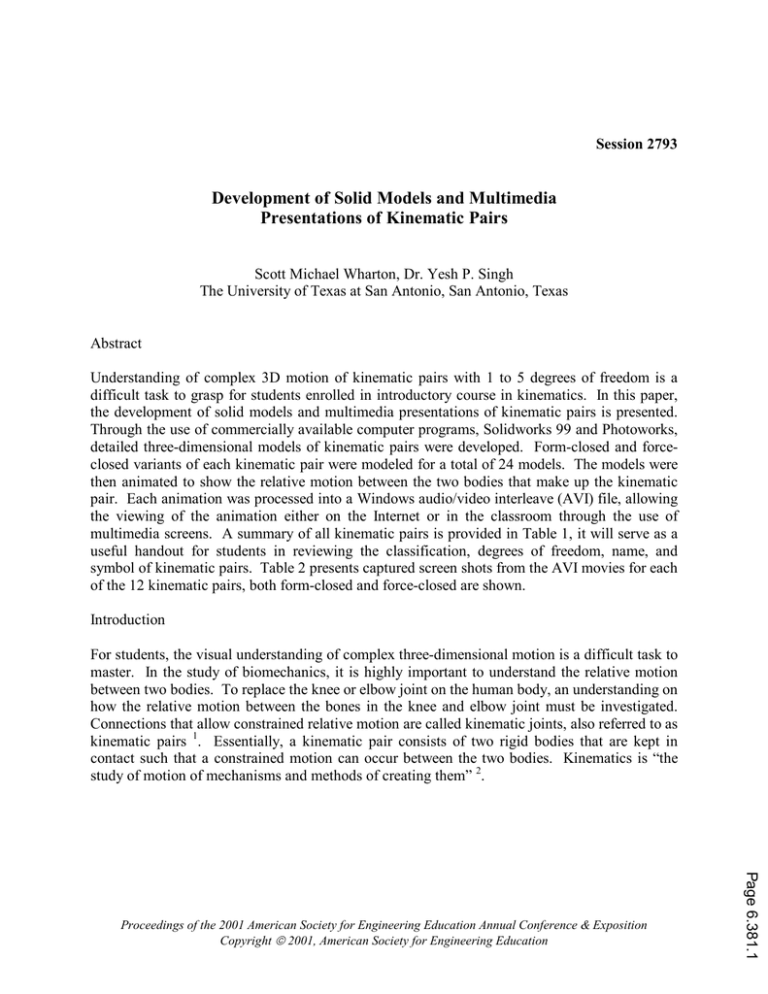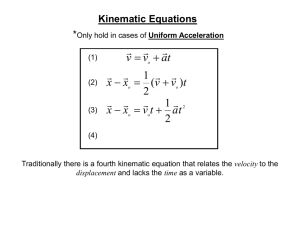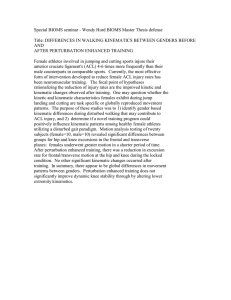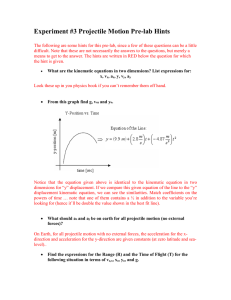Paper - Asee peer logo
advertisement

Session 2793 Development of Solid Models and Multimedia Presentations of Kinematic Pairs Scott Michael Wharton, Dr. Yesh P. Singh The University of Texas at San Antonio, San Antonio, Texas Abstract Understanding of complex 3D motion of kinematic pairs with 1 to 5 degrees of freedom is a difficult task to grasp for students enrolled in introductory course in kinematics. In this paper, the development of solid models and multimedia presentations of kinematic pairs is presented. Through the use of commercially available computer programs, Solidworks 99 and Photoworks, detailed three-dimensional models of kinematic pairs were developed. Form-closed and forceclosed variants of each kinematic pair were modeled for a total of 24 models. The models were then animated to show the relative motion between the two bodies that make up the kinematic pair. Each animation was processed into a Windows audio/video interleave (AVI) file, allowing the viewing of the animation either on the Internet or in the classroom through the use of multimedia screens. A summary of all kinematic pairs is provided in Table 1, it will serve as a useful handout for students in reviewing the classification, degrees of freedom, name, and symbol of kinematic pairs. Table 2 presents captured screen shots from the AVI movies for each of the 12 kinematic pairs, both form-closed and force-closed are shown. Introduction For students, the visual understanding of complex three-dimensional motion is a difficult task to master. In the study of biomechanics, it is highly important to understand the relative motion between two bodies. To replace the knee or elbow joint on the human body, an understanding on how the relative motion between the bones in the knee and elbow joint must be investigated. Connections that allow constrained relative motion are called kinematic joints, also referred to as kinematic pairs 1. Essentially, a kinematic pair consists of two rigid bodies that are kept in contact such that a constrained motion can occur between the two bodies. Kinematics is “the study of motion of mechanisms and methods of creating them” 2. Page 6.381.1 Proceedings of the 2001 American Society for Engineering Education Annual Conference & Exposition Copyright 2001, American Society for Engineering Education A kinematic pair can permit 1 to 5 degrees of freedom of motion between two contacting bodies. Degrees of freedom can be defined as the number of independent parameters needed to specify the relative positions of the two bodies in contact 3. An unconstrained rigid body has six degrees of freedom, three translations and three rotations about the three orthogonal axes. Kinematic pairs are divided into five different classes based on the degrees of freedom that the kinematic joint possesses 1. A class I pair has one degree of freedom and the class II pair has two degrees of freedom. The classification stops at class V because beyond five degrees of freedom the rigid bodies no longer have a contact constrained motion between them. Reuleaux introduced another classification of kinematic pairs based on type of contact between the two bodies 1. In this classification system, kinematic pairs are placed in one of the two groups, lower kinematic pairs and higher kinematic pairs. For a kinematic joint to be classified as a lower kinematic pair, the two rigid bodies have either area or surface contact. Higher kinematic pairs have either line or point contact. Form-closed and force-closed terminology helps to define the appearance of kinematic pairs. Form-closed kinematic joints use the surfaces of one body to constrain the motion of the other body in the pair. No other bodies or forces are necessary to constrain the motion of the moving body. Force-closed kinematic joints require an additional force to help constrain the motion of the moving body. The additional force may include gravity or springs which help to keep the two bodies in contact with one another. For force-closed kinematic pairs, a simple algebraic equation can be used to determine the degrees of freedom that the kinematic joint possesses. The algebraic equation states that when the number of point contacts, nc, between the kinematic pairs is subtracted from six times the difference between the number of bodies, nL, and one, the difference is the number of degrees of freedom that the pair possesses. The number six comes from the fact that an unconstrained rigid body has six degrees of freedom. The force-closed equation is shown below. DFspatial = 6(n L − 1) − nC (1) Since there are only two rigid bodies in a kinematic pair, Equation (1) simplifies to the following. DFspatial = 6 − nC (2) To help identify kinematic pairs, the kinematic joints have been given names and symbols 1. For the simple case of a one-degree of freedom kinematic joint that permits rotation only, the name revolute is given. The corresponding symbol for the revolute joint is the capital letter R. Proceedings of the 2001 American Society for Engineering Education Annual Conference & Exposition Copyright 2001, American Society for Engineering Education Page 6.381.2 Without a complete understanding of kinematic pairs and their motions, a student cannot begin to understand the more complex motions of biomedical joints. For students having trouble visualizing complex three-dimensional motion of kinematic pairs by sketches and descriptions given in textbooks, the use of multimedia animations can be of significant help in understanding the relative motion. Three-Dimensional Modeling Through the use of SolidWorks 99, twelve different kinematic pairs were modeled 4. For each of the kinematic pairs, force-closed and form-closed models were developed. A total of 24 solid models are created. Each kinematic pair has two rigid bodies, a moving body and a fixed body. Each rigid body was modeled using Solidworks 99. Each solid model was detailed to allow for clearances and fillets. Color-coding of the kinematic pair components was used to help distinguish the fixed and moving component. The moving component of each model was colored green and the fixed rigid body was colored gray. Upon completion of the two rigid bodies, an assembly drawing was created using the moving and fixed models. The fixed model was first imported into the assembly drawing and constrained to the assembly drawing’s coordinate system. This constraint forced the rigid body to be fixed in the assembly space of the drawing. The moving rigid body was then imported into the assembly drawing. Through the use of Solidwork’s mating reference system, the moving body was mated with the fixed body to complete the assembly of the kinematic pairs. The mating process required that the moving body still be allowed all degrees of freedom that would be exhibited by the kinematic pair. For example, in the form-closed revolute joint, the z-axis of the fixed body was mated with the z-axis of the moving body. This mating allowed the moving body to exhibit two degrees of freedom, rotation about the z-axis and translation along the z-axis. Since the revolute joint has only one degree of freedom a second mating reference was needed to complete the mating process. The second mating reference was the point origin of the fixed body must be coincident with the point origin of the moving body. The two mating references together constrained the revolute assembly to exhibit only the rotation about the z-axis of the assembly. A similar process of mating was carried out for each of the remaining 23 assembly models. The coordinate system for each body was added to the assembly drawing to help with visualization of translation(s) and/or rotation(s). The global axes were fixed in space and these correspond to the fixed rigid body. The local coordinate system was then constrained with the moving body to reproduce all the degrees of movement that the moving body produced. If the moving body rotated about its x-axis the local axis would also rotate about its x-axis. Each coordinate system was color coded for ease of visualization. The global axes were colored blue and the local axes were colored in red. Model Rendering Proceedings of the 2001 American Society for Engineering Education Annual Conference & Exposition Copyright 2001, American Society for Engineering Education Page 6.381.3 Through the use of Photoworks 99, each model was rendered with shadow effects to help define the three-dimensional nature of each model 5. Photoworks 99 is an add-on program that works within the Solidworks program. Photoworks 99 allows the user to define the surface appearance of the models. Aesthetically pleasing surfaces were chosen not to detract from the model. Each rendered model was then saved in a JPG picture format. The JPG picture format is a digital graphic image that is suitable to be used on the World Wide Web and many other computer programs. Kinematic Pairs The following 12 figures show the kinematic joints that were modeled using the Solidworks 99 solid modeler. Each figure was rendered using Photoworks 99 and shown in the JPG format. The axis systems have been removed from the pictures for better viewing of the kinematic pair models. A revolute joint model is shown in figure 1 given below. Figure 1(a) shows the form-closed version of the revolute joint and Fig. 1(b) shows the force-closed revolute joint. Counting the number of contact points of the force-closed model shows there are five contact points. Three of the contact points are between the pyramid that is recessed in the fixed rigid body and the sphere of the moving body. The other two contact points are between the spheres of the moving body and the flat surface of the fixed rigid body. Using equation (2), it can be shown that the forceclosed revolute joint has one degree of freedom. Knee and elbow joints of the human body are sometimes modeled as a revolute joint for simplicity. Fig. 1 Revolute Joint, R DOF = 1 Figure 2 shows the form-closed and force-closed models of the prism joint. The prism joint can only translate along one axis and therefore has one degree of freedom. The capital letter P is the given symbol for the prism joint. Fig. 2 Prism Joint, P DOF = 1 Proceedings of the 2001 American Society for Engineering Education Annual Conference & Exposition Copyright 2001, American Society for Engineering Education Page 6.381.4 A helical joint is shown in figure 3. It is different from the revolute and prism joint that it appears to have two degrees of freedom, one rotation and one translation. The reason the helical joint is considered to have one degree of freedom is that the rotation and translation are coupled; one cannot exist with out the other. For a given amount of rotation, the moving body will translate a fixed amount. A nut and bolt is a good example of a helical joint. The capital letter H is the symbol used for the helical joint. Fig. 3 Helical Joint, H DOF = 1 The first of the class II kinematic pairs is the slotted spheric joint shown in figure 4. The slotted spheric joint has two degrees of freedom. The degrees of freedom consist of two rotations. The symbol used for the slotted spheric joint is SL. Fig. 4 Slotted Spheric Joint, SL DOF = 2 A cylinder joint is shown in Figure 5. It has two degrees of freedom, one rotation and one translation. Unlike the helical joint, the rotation and translation in the cylinder joint are independent of one another. For a kinematic joint to be called a cylinder joint, both the rotation and translation must occur upon the same axis. The capital letter C is used as the symbol for the cylinder joint. Fig. 5 Cylinder Joint, C DOF = 2 Proceedings of the 2001 American Society for Engineering Education Annual Conference & Exposition Copyright 2001, American Society for Engineering Education Page 6.381.5 Figure 6 illustrates a cam joint. Like the cylinder joint, the cam joint has two degrees of freedom, one rotation, and one translation. Unlike the cylinder joint, the cam joint’s rotation and translation occur upon different axis. The symbol for the cam joint is Ca. Fig. 6 Cam Joint, Ca DOF = 2 The spheric pair joint shown in Figure 7 is a class III kinematic pair. The spheric pair joint has three rotations, one about each of its principle axis directions. For biomedical joints, the hip joint is modeled as a spheric pair. The spheric pair is also known as a ball and socket joint. The capital letter S is used as the symbol for the spheric pair joint. Fig. 7 Spheric Pair Joint, S DOF = 3 The sphere slotted cylinder pair has two rotations and one translation. Returning to equation 2, one can see that the sphere slotted cylinder has 3 degrees of freedom. The contact points are one between the flat plane of the fixed rigid body and the sphere of the moving body and two contact points exist between the v-groove in the fixed body and the sphere of the moving body. The symbol SS is given to the sphere slotted cylinder joint. The sphere slotted cylinder is shown in figure 8. Fig. 8 Sphere Slotted Cylinder Joint, SS DOF = 3 Proceedings of the 2001 American Society for Engineering Education Annual Conference & Exposition Copyright 2001, American Society for Engineering Education Page 6.381.6 The two translations and the one rotation make the plane pair joint a class III kinematic pair. The symbol for the plane pair joint is PL. Using the Reuleaux classification system, the plane pair joint is classified as a lower kinematic pair. Viewing of the form-closed model shows that the surfaces of the moving body are in contact with the surface of the fixed body. Figure 9 illustrates the plane pair joint. Fig. 9 Plane Pair Joint, PL DOF = 3 The first kinematic pair in the class IV classification is the sphere groove joint. Similar to the sphere slotted cylinder joint, the sphere groove permits 3 rotations and one translation. Sg is the symbol for the sphere groove joint. The sphere groove joint is shown in figure 10. Fig. 10 Sphere Groove Joint, Sg DOF = 4 The cylinder plane pair is pictured in Figure 11. Using equation (2) and counting the two point contacts between the flat plane of the fixed rigid body and the two spheres of the moving body, it can be shown that the cylinder plane has four degrees of freedom. Viewing the form-closed model, it can be shown that the cylinder plane pair is a higher kinematic pair based on the Reuleaux classification system. There exists only a line contact between the cylinder of the moving body and the surface of the fixed rigid body. The symbol given to the cylinder plane pair is Cp. Fig. 11 Cylinder Plane Pair Joint, CP DOF = 4 Proceedings of the 2001 American Society for Engineering Education Annual Conference & Exposition Copyright 2001, American Society for Engineering Education Page 6.381.7 A class V kinematic pair is the sphere-plane joint. An example of a sphere plane joint is a ball on a flat table. The ball can perform three rotations, one about each of its principle axis directions and two translations along the surface of the table. The sphere plane joint symbol is SP. Figure 12 shows the form-closed and force-closed models of a sphere-plane joint. Fig. 12 Sphere Plane Joint, SP DOF = 5 Animation of Kinematic Pairs To animate each model, animating capabilities of Solidworks 99 software were used 6. Each degree of freedom for every model was simulated using the software and saved as a Windows AVI movie. An AVI movie is a combination of still pictures with small delays between each picture to simulate animation. For a joint with multiple degrees of freedom, each degree of freedom was animated separately to help identify each movement. During the filming of each degree of freedom, further constraints were added to each assembly to insure that only one degree of freedom would be produced for that segment of film. The movies of each individual motion were then combined to make one movie that showed each degree of freedom in turn. The program used to combine the individual AVI files was ImageForge by CursurArts 7. Kinematic names and symbols were then added to the AVI files using ImageForge. Additional information about each kinematic pair, number of degrees of freedom, form-closed or forceclosed and the magnitude and type of each movement the kinematic pair exhibited, were added into the AVI movies. Summary Through the use of commercially available computer programs, solid models and animation of kinematic pairs were developed and the complex motions of kinematic pairs are presented. The Windows AVI files are created that can be placed on the World Wide Web for viewing or brought to the classroom through the use of multimedia presentation equipment. Table 1 provides a summary of all kinematic pairs. It will serve a useful handout to students to review the classification, degrees of freedom, name, and symbol of many kinematic pairs. Table 2 shows screen captured pictures from the multimedia AVI movie files. Students, who are having trouble visualizing complex three-dimensional motion of kinematic pairs by description provided in textbooks, will find the animations significantly useful. Page 6.381.8 Proceedings of the 2001 American Society for Engineering Education Annual Conference & Exposition Copyright 2001, American Society for Engineering Education Bibliography 1. Soni, A.H., 1974, Mechanism Synthesis and Analysis, Robert E. Krieger Publiching Company, Florida. 2. Erdman, Arthur G., and Sandor, George N., 1997, Mechanism Design, Analysis and Synthesis, Volume 1, Third Edition, Prentice Hall, New Jersey. 3. Wilson, Charles E., and Sadler, J. Peter, 1993, Kinematics and Dynamics of Machinery, Second Edition, Harper Collins College Publishers, New York. 4. Solidworks, 1999, Solidworks 99 User’s Guide, Solidworks Corporation, Massachusetts. 5. Lightworks Design Limited, 1999, Photoworks Help, Lightworks Design Limited., United Kingdom. 6. Immersive Design, Inc., 1999, Solidworks Animator Help Topics, Immersive Design, Inc. Massachesett. 7. ImageForge, 2000, ImageForge Help Topics, CursorArts Company, Oregon. SCOTT MICHAEL WHARTON Scott Wharton received his master’s degree in Mechanical Engineering for the University of Texas at San Antonio in the December 2000. Before returning to graduate school, Scott worked for Exponent, Inc. in Houston as a laboratory technician and with C&S Metal Fabricators in Houston as the factory supervisor. Scott received his B.S. in Engineering Technology from Texas A&M University in May 1995. Dr. YESH P. SINGH Yesh P. Singh is an Associate Professor of Mechanical Engineering at the University of Texas at San Antonio (UTSA). He also serves as Chair of ME Graduate Program and Director of the Engineering Machine Shop. He joined Mechanical Engineering at UTSA in September 1985 after 23 years of broad-based hands-on Mechanical Design experience in industries in USA, formal USSR, and India. He was elected to ASME Fellow grade in 1992. Page 6.381.9 Proceedings of the 2001 American Society for Engineering Education Annual Conference & Exposition Copyright 2001, American Society for Engineering Education KINEMATIC PAIRS Table 1 Class Degrees of Freedom Name and Symbol Diagram FormClosed Revolute – R I 1 Prism – P R P H Helical – H ForceClosed R P H FormClosed Slotted Spheric - SL II 2 Cylinder – C SL C Ca Cam - Ca ForceClosed SL C Ca Spheric Pair – S III 3 Sphere Slotted Cylinder - SS FormClosed S SS PL ForceClosed Plane Pair - PL S SS PL FormClosed Sphere Groove - Sg IV 4 Sg CP Cylinder Plane Pair CP ForceClosed Sg CP FormClosed V 5 Sphere Plane - SP SP SP Proceedings of the 2001 American Society for Engineering Education Annual Conference & Exposition Copyright 2001, American Society for Engineering Education Page 6.381.10 ForceClosed KINEMATIC PAIRS MULTIMEDIA MOVIE SCREEN CAPTURES Table 2 Proceedings of the 2001 American Society for Engineering Education Annual Conference & Exposition Copyright 2001, American Society for Engineering Education Page 6.381.11 KINEMATIC PAIRS MULTIMEDIA MOVIE SCREEN CAPTURES Table 2 Continued Proceedings of the 2001 American Society for Engineering Education Annual Conference & Exposition Copyright 2001, American Society for Engineering Education Page 6.381.12



